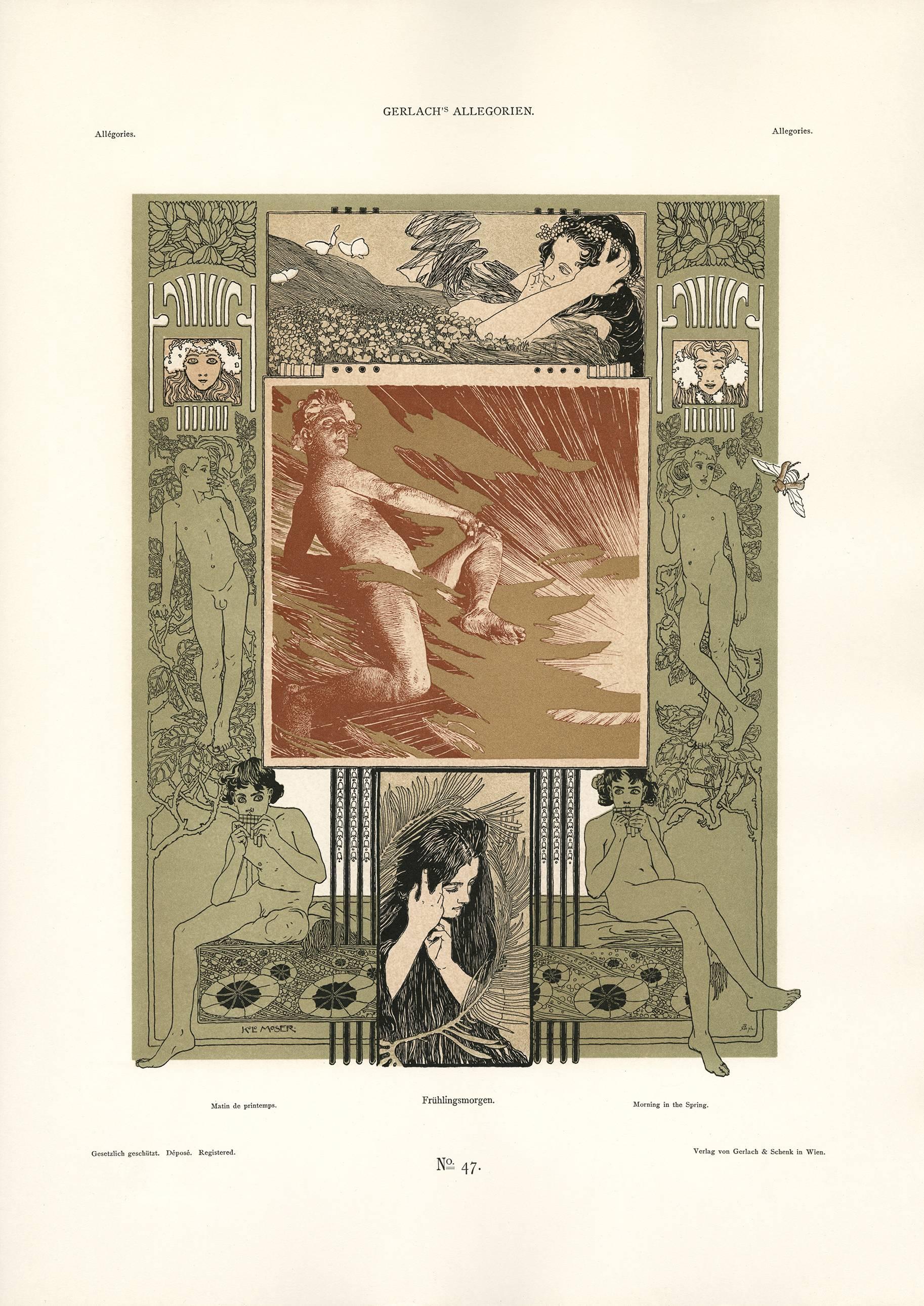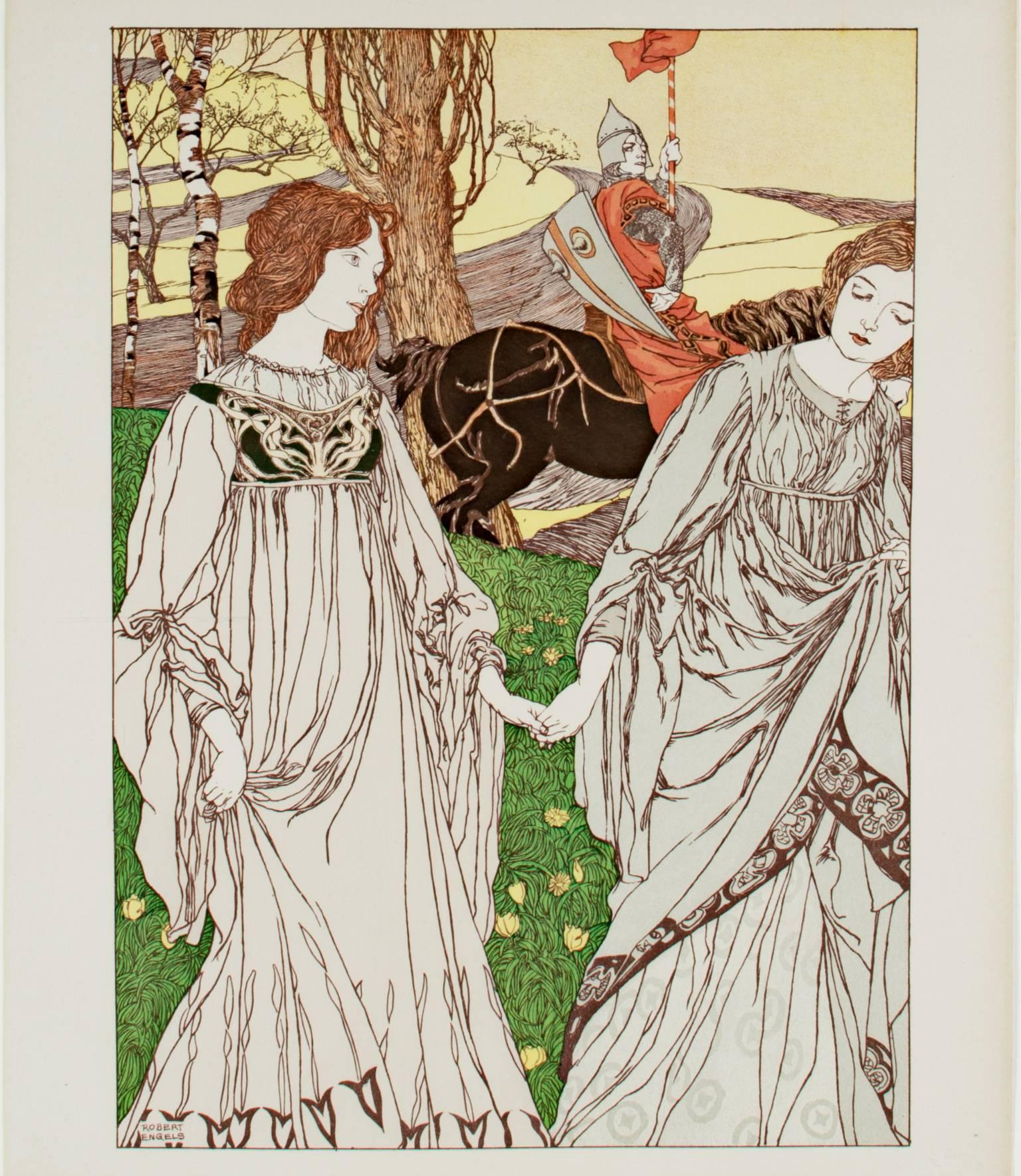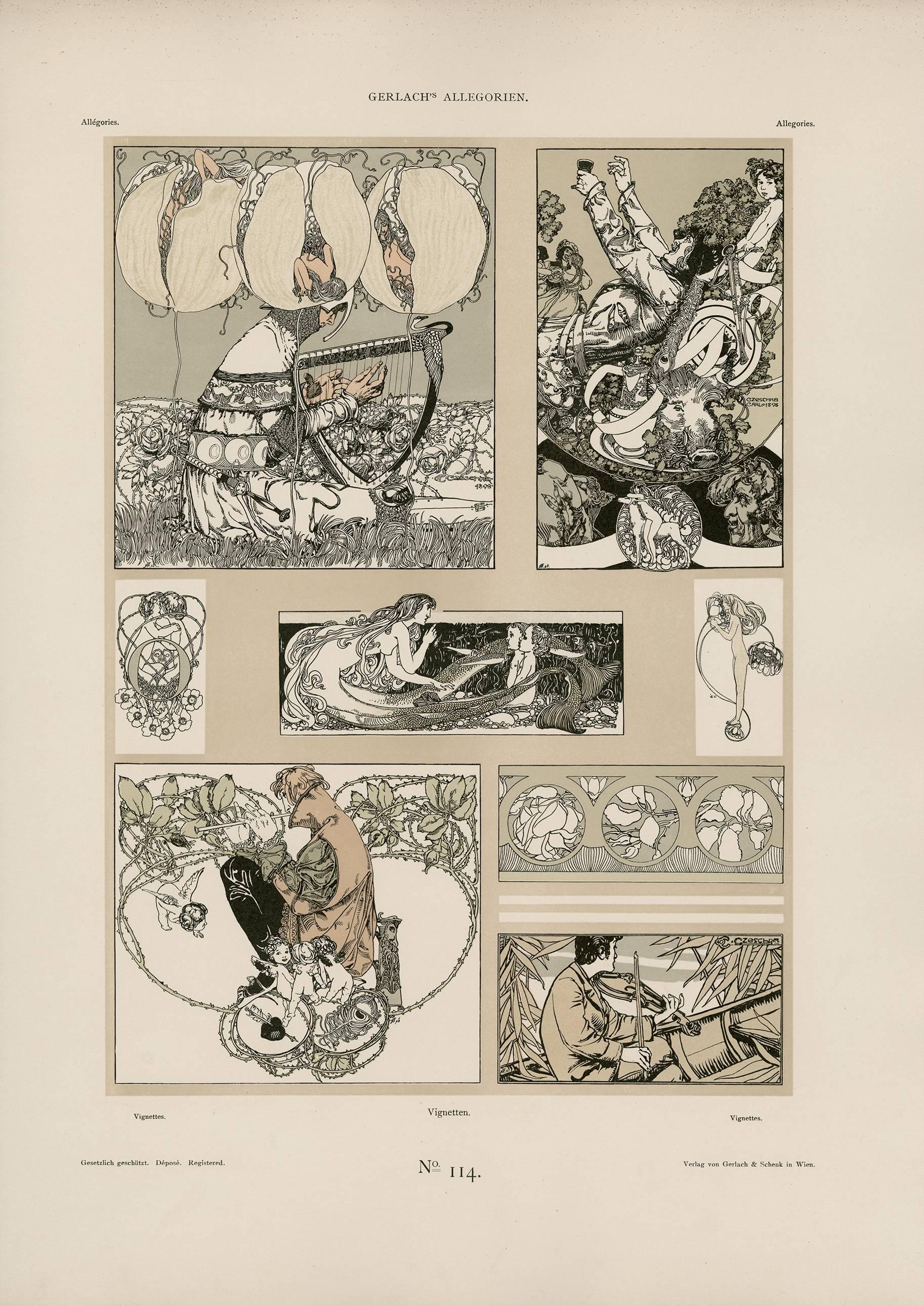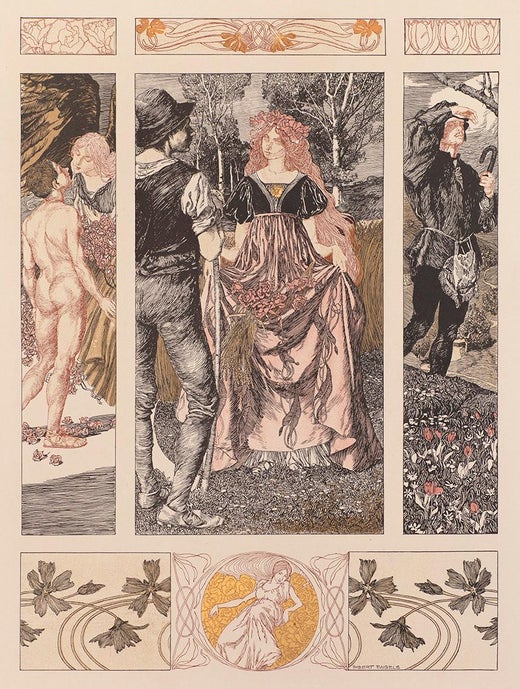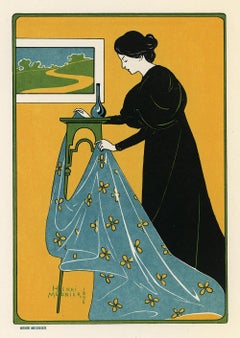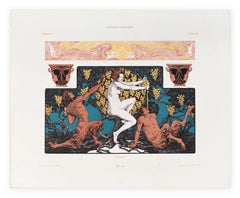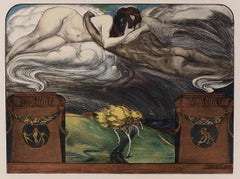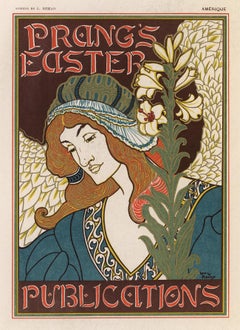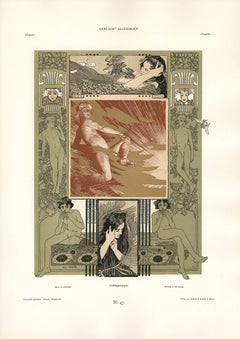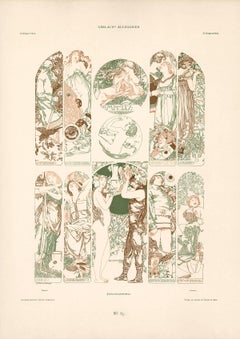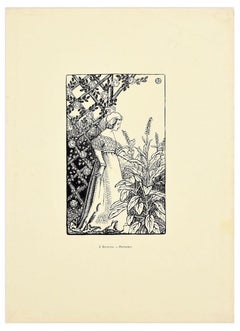Items Similar to Spring by Robert Engels, Medieval Art Nouveau lithograph with gold ink, 1897
Want more images or videos?
Request additional images or videos from the seller
1 of 7
Robert EngelsSpring by Robert Engels, Medieval Art Nouveau lithograph with gold ink, 18971897
1897
$500
£385.44
€438.10
CA$712.43
A$775.05
CHF 408.98
MX$9,321.27
NOK 5,159.13
SEK 4,801.38
DKK 3,271.89
About the Item
Allegorien-Neue Folge was a serialized folio published in installments between 1895 and 1900. Martin Gerlach, its publisher, was inspired by the rise of modernist design in Vienna and selected those who were demonstrating a command of the style to contribute works to the series and selected the most exciting and innovative artists of the region to contribute works to the series, including Gustav Klimt, Koloman Moser, and Carl Otto Czeschka. Each plate explores a different theme or collection of topics, such as dance, astronomy, electricity, and graphic arts, which brought a new aesthetic of design to the traditional allegory genre.
Lithograph of Robert Engels’s Spring, published as Plate 55 in Gerlach’s Allegorien by Gerlach & Schenk, Vienna.
This work is printed with dense, shimmering gold ink details throughout the design elements.
Notable museum collections include: MAK - Museum of Applied Arts, Vienna
- Creator:Robert Engels (1866 - 1926, German)
- Creation Year:1897
- Dimensions:Height: 17.25 in (43.82 cm)Width: 13.75 in (34.93 cm)Depth: 0.2 in (5.08 mm)
- Medium:
- Movement & Style:
- Period:
- Condition:
- Gallery Location:Chicago, IL
- Reference Number:1stDibs: LU149329354062
Robert Engels
Robert Engels studied in Dusseldorf and moved shortly thereafter to work in Munich. Later, he became a professor at a school of applied arts at the KGS in Munich. He created many decorative prints as well as stained glass windows and also created compositions to illustrate Joseph Bedier's rendition of "Tristan and Iseult." Engels created "Le Passant" or "The Passerby" for the monthly publication L'Estampe Moderne, which featured illustrations by multiple important Art Nouveau artists and designers. The prints from this publication are currently highly valued.
About the Seller
5.0
Vetted Professional Seller
Every seller passes strict standards for authenticity and reliability
Established in 1999
1stDibs seller since 2021
42 sales on 1stDibs
- ShippingRetrieving quote...Shipping from: Chicago, IL
- Return Policy
More From This Seller
View AllGonthier-Meymans by Henri Meunier, Art Nouveau Japon lithograph, 1897
By Henri Meunier
Located in Chicago, IL
Henri Meunier’s Gonthier-Meymans lithographic poster, published by Verlag von Gerhard Kühtmann in Dresden, 1897. While this poster was printed in multiple sizes and formats, this edi...
Category
1890s Art Nouveau Prints and Multiples
Materials
Lithograph
The Thirst, Plate 52 from Gerlach's Allegorien, Vienna Secession lithograph
Located in Chicago, IL
Wilhelm List, a friend and follower of Gustav Klimt, was a founder and leading member of the Vienna Secession and contributor to its official magazine, Ver Sacrum...
Category
1890s Vienna Secession Prints and Multiples
Materials
Lithograph
Electricity by Ignatius Taschner, Art Nouveau lithograph, 1897
Located in Chicago, IL
Lithograph of Ignatius Taschner’s Electricity, published as Plate 95 in Gerlach’s Allegorien by Gerlach & Schenk, Vienna. This artwork arrives accompanied by a certificate of authenticity.
Allegorien-Neue Folge...
Category
1890s Art Nouveau Prints and Multiples
Materials
Lithograph
Prang's Easter by Louis Rhead, Art Nouveau Japon lithograph, edition of 25, 1897
By Louis Rhead
Located in Chicago, IL
“America was quick to reveal strong Art Nouveau voices; it was Louis Comfort Tiffany who encouraged Bing to open his salon, and artists Will Bradley and Ethel Reed exhibited a Japonist simplicity that presented a strong, refined take on the Art Nouveau ideal. Louis Rhead was born in England but emigrated to the United States in 1883 at the age of 24, and quickly found himself celebrated both in the United States and in France, exhibiting his designs in the prestigious Salon des Cent in Paris in 1897.”
-Quoted from Flowering Lines: Rare Art Nouveau Graphics 1883-1911 by Thomas Negovan (2017)
Lithograph of Louis Rhead’s Prang’s Easter Publications, published in 1897 by Imprimerie Chaix, the printing house known for publishing the works of Belle Epoque master Jules Chéret. This example was printed with a plate of shimmering gold ink.
While this poster was printed in multiple sizes and formats, this 1897 edition of 25 strikes on Japon paper is the most desirable and extremely scarce edition. Japon paper allows inks to rest upon its surface rather than being absorbed by a more permeable paper stock. The rare, small format poster lithographs created at this time were printed using rich, dense, lead inks. This world-class example of lithography captures superior resolution and color-richness to that of its large-format counterpart.
This artwork is presented in archival rag mat and arrives accompanied by a certificate of authenticity.
Notable museum collections containing this work include: Metropolitan Museum of Art, New York City (medium-format version on paper) (1984.1202.146)
Notable museum collections featuring works by John Louis...
Category
1890s Art Nouveau Prints and Multiples
Materials
Lithograph
Illustration for Hésperus by Carlos Schwabe, Symbolist fantasy aquarelle, 1904
By Carlos Schwabe
Located in Chicago, IL
Lithograph from Carlos Schwabe’s series of hand-colored Symbolist fantasy illustrations for Catulle Mendès’ Hésperus, published in 1904 by Société de pr...
Category
Early 1900s Symbolist Prints and Multiples
Materials
Paper, Aquatint
Prang's Easter by Louis Rhead, Art Nouveau lithograph, 1897
By Louis Rhead
Located in Chicago, IL
“America was quick to reveal strong Art Nouveau voices; it was Louis Comfort Tiffany who encouraged Bing to open his salon, and artists Will Bradley and Ethel Reed exhibited a Japonist simplicity that presented a strong, refined take on the Art Nouveau ideal. Louis Rhead was born in England but emigrated to the United States in 1883 at the age of 24, and quickly found himself celebrated both in the United States and in France, exhibiting his designs in the prestigious Salon des Cent in Paris in 1897.”
-Quoted from Flowering Lines: Rare Art Nouveau Graphics 1883-1911 by Thomas Negovan (2017)
Lithograph of Louis Rhead’s Prang’s Easter Publications, published in 1897 by Imprimerie Chaix, the printing house known for publishing the works of Belle Epoque master Jules Chéret. This example was printed with a plate of shimmering gold ink.
This piece is presented professionally framed using all archival materials, including a hand-wrapped silk mat and gold fillet. This work arrives accompanied by a certificate of authenticity.
Notable museum collections containing this work include: Metropolitan Museum of Art, New York City (medium-format version) (1984.1202.146)
Notable museum collections featuring works by John Louis...
Category
1890s Art Nouveau Prints and Multiples
Materials
Lithograph
You May Also Like
Gerlach's Allegorien Plate #47: "Morning in the Spring" Lithograph
By Koloman Moser
Located in Palm Beach, FL
Koloman Moser
(1868 –1918), AUSTRIAN
Instead of applying his flair and art education solely to painting, Koloman Moser embodied the idea of Gesamt Kunstwerk (all-embracing art work) by designing architecture, furniture, jewelry, graphics, and tapestries meant to coordinate every detail of an environment. His work transcended the imitative decorative arts of earlier eras and helped to define Modernism for generations to come. Moser achieved a remarkable balance between intellectual structure (often geometric) and hedonistic luxury.
Collaborating with Gustav Klimt and Josef Hoffmann, the artist was an editor and active contributor to Ver Sacrum, (Sacred Spring), the journal of the Viennese Secession that was so prized for its aesthetics and high quality production that it was considered a work of art. The magazine featured drawings and designs in the Jugendstil style (Youth) along with literary contributions from distinguished writers from across Europe. It quickly disseminated both the spirit and the style of the Secession.
In 1903 Moser and Hoffmann founded and led the Wiener Werkstatte (Viennese Workshop) a collective of artisans that produced elegant decorative arts items, not as industrial prototypes but for the purpose of sale to the public. The plan, as idealistic then as now, was to elevate the lives of consumers by means of beautiful and useful interior surroundings.
Moser’s influence has endured throughout the century. His design sensibility is evident from the mid-century modern furniture of the 1950s and ‘60s to the psychedelic rock posters...
Category
1890s Vienna Secession Figurative Prints
Materials
Paper
Gerlach's Allegorien Plate #83: "Seasons" Lithograph by Carl Otto Czeschka
By Carl Otto Czeschka
Located in Palm Beach, FL
after Carl Otto Czeschka, (1878-1960), Austrian
A leading member of the Vienna Secession and later the Wiener Werkstätte (Viennese Workshop), Carl Otto Czeschka was a vital f...
Category
1890s Vienna Secession Figurative Prints
Materials
Lithograph
Printemps - Original Woodcut Print by J. Beltrand - 1899
By Jacques Beltrand
Located in Roma, IT
Image dimensions: 15.8 x 9.8 cm.
Printemps is an original artwork realized by Jacques Beltrand in 1899.
Original woodcut on paper.
Inscripted on the lower margin: J. Beltrand - Printemps.
Good conditions except for a very small rip on the right upper side.
Beautiful and fresh print representing a female figure simbolizing the spring. The young woman is smelling fresh flowers in a garden. The work is a very good example of Art Dèco illustration of that period in which the Art Nouveau was bursting.
This beautiful work has been realized by Jacques Beltrand (Paris, 1874 - 1977) a Fresh painter, engraver, xylographer. He collaborated with his father Tony Beltrand from 1890. He soon became a master of the xylograph and book illustrator. He exhibited at the Society of Painters and Engravers of Paris and became a member of the Conseil Supérieur des Beaux-Arts and of the Comité des Tuileries where he exhibited until 1944. Most of his works are preserved in the French Prints Cabinet.
Category
1890s Art Nouveau Figurative Prints
Materials
Woodcut
Spring - Original lithograph - 1897
By Maurice Eliot
Located in Paris, IDF
Maurice ELIOT
Spring
Original lithograph
Plate signed
1897/98
Printed on paper Vélin
Size 40 x 31 cm (c. 16 x 12")
INFORMATION : Published by 'Estampe Moderne, Paris, 1897-1899 a...
Category
1890s Art Nouveau Figurative Prints
Materials
Lithograph
"Le Passant, " Original Color Lithograph
By Robert Engels
Located in Milwaukee, WI
"Le Passant" is an original Art Nouveau color lithograph. It depicts two women in the foreground wearing medieval white robes and a knight passing behind them on a black horse. Features the L'Estampe Moderne blindstamp bottom right hand corner. 1898.
15 3/4" x 12" art
23" x 19 1/4" framed
Robert Engels studied in Dusseldorf and moved shortly thereafter to work in Munich. Later, he became a professor at a school of applied arts at the KGS in Munich. He created many decorative prints as well as stained glass windows and also created compositions to illustrate Joseph Bedier's rendition of "Tristan and Iseult...
Category
1890s Art Nouveau Figurative Prints
Materials
Lithograph
Gerlach's Allegorien Plate #114: "Vignettes" Lithograph by Carl Otto Czeschka
By Carl Otto Czeschka
Located in Palm Beach, FL
after Carl Otto Czeschka, (1878-1960), Austrian
A leading member of the Vienna Secession and later the Wiener Werkstätte (Viennese Workshop), Carl Otto Czeschka was a vital figu...
Category
1890s Vienna Secession Figurative Prints
Materials
Lithograph
More Ways To Browse
Vienna Art Nouveau
Metropolitan Museum Of Art Tiffany Stained Glass
Owen Bowen
Oxford Limited
Paul Insect
Peter Blake Alphabet
Picasso Faunes Et Flores
Picasso Vallauris Poster
Pose Jordan Nickel
Poster Maroc Vintage
Poster Maroc
Poster Ville Vintage
Princess Leia
Prints Of Maurice Utrillo
Renoir Poster
The Angelus
Valentine Hugo
Victorian Greenhouse
